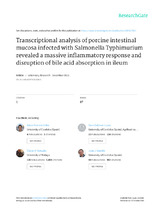Transcriptional analysis of porcine intestinal mucosa infected with Salmonella Typhimurium revealed a massive inflammatory response and disruption of bile acid absorption in ileum
Autor
Herrera Uribe, Juber
Collado-Romero, Melania
Zaldívar-López, Sara
Arce Jiménez, Cristina
Bautista, Rocío
Carvajal, Ana
Cirera, Susanna
Gonzalo Claros, M.
Garrido, Juan J.
Editor
Biomed CentralFecha
2016Materia
SalmonellosisInfected pork meat
METS:
Mostrar el registro METSPREMIS:
Mostrar el registro PREMISMetadatos
Mostrar el registro completo del ítemResumen
Infected pork meat is an important source of non-typhoidal human salmonellosis. Understanding of molecular
mechanisms involved in disease pathogenesis is important for the development of therapeutic and preventive strategies.
Thus, hereby we study the transcriptional profiles along the porcine intestine during infection with Salmonella
Typhimurium, as well as post-transcriptional gene modulation by microRNAs (miRNA). Sixteen piglets were orally challenged
with S. Typhimurium. Samples from jejunum, ileum and colon, collected 1, 2 and 6 days post infection (dpi)
were hybridized to mRNA and miRNA expression microarrays and analyzed. Jejunum showed a reduced transcriptional
response indicating mild inflammation only at 2 dpi. In ileum inflammatory genes were overexpressed (e.g.,
IL-1B, IL-6, IL-8, IL1RAP, TNFα), indicating a strong immune response at all times of infection. Infection also down-regulated
genes of the FXR pathway (e.g., NR1H4, FABP6, APOA1, SLC10A2), indicating disruption of the bile acid absorption
in ileum. This result was confirmed by decreased high-density lipoprotein cholesterol in serum of infected pigs. Ileal
inflammatory gene expression changes peaked at 2 dpi and tended to resolve at 6 dpi. Furthermore, miRNA analysis
of ileum at 2 dpi revealed 62 miRNAs potentially regulating target genes involved in this inflammatory process (e.g.,
miR-374 and miR-451). In colon, genes involved in epithelial adherence, proliferation and cellular reorganization were
down-regulated at 2 and 6 dpi. In summary, here we show the transcriptional changes occurring at the intestine
at different time points of the infection, which are mainly related to inflammation and disruption of the bile acid
metabolism.
© 2016 Uribe et al. This article is distributed under the terms of the Creative Commons Attribution 4.0 International License
(http://creativecommons.org/licenses/by/4.0/), which permits unrestricted use, distribution, and reproduction in any medium,
provided you give appropriate credit to the original author(s) and the source, provide a link to the Creative Commons license,
and indicate if changes were made. The Creative Commons Public Domain Dedication waiver (http://creativecommons.org/
publicdomain/zero/1.0/) applies to the data made available in this article, unless otherwise stated.

